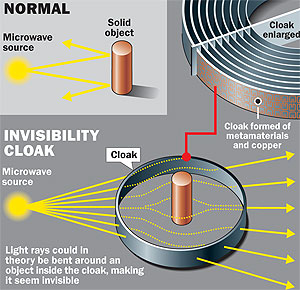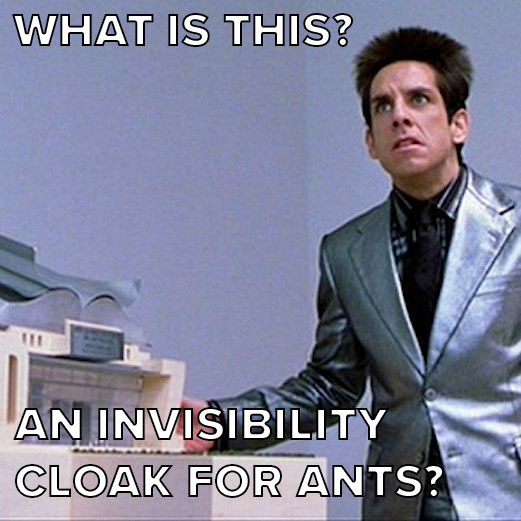“For generations, the topic of invisibility has been of great interest. Although it was once dismissed as science fiction, it has now become reality on a small scale. Physics textbooks around the world must be rewritten and scientists must admit that they were wrong” (Michio Kaku). In 2011, two independent research teams, one from MIT and the other from England and Denmark, had designed carpet cloaks that hide small 3D objects by using natural crystals. Until now, things were made invisible by using metamaterials. Metamaterials are created from multiple elements usually consisting of metals and plastics which produce properties that do not occur naturally such as light, sound, and physical properties; the downside of metamaterials, they can only render in two-dimensions and just at microwave frequencies.
 On the other hand, the cloaking device has adopted calcite prisms, a type of naturally occurring crystal, to build carpet cloaks. The bottom of the device is notched with a small triangle that looks like a curved mirror. The optical properties of the calcite prisms cause the curved mirror to look like a flat plane when viewed from certain angles; Anything that is hiding in the notch vanishes. The only downfall thus far, the carpet cloaks can only make objects the size of an ant disappear. Michio Kaku, a Japanese American theoretical physicist, futurist, and popularizer of science and once a non-believer of the carpet cloaks says, “There are many hurdles to overcome before we have something similar to and as technologically advanced as Harry Potter’s cloak.” He then discusses three main hurdles in creating cloaks large enough to make more significant objects, such as a car or person, disappear. The first hurdle scientists must overcome is that they have to make a cloak that works in the visible range. Second, since the objects are so small right now, the future cloaks must be scaled up to cover larger objects such as a car or person. However, the process of building such a cloak would be costly and time-consuming, since it is done through nanotechnology. Finally, from a distance, the carpet cloak looks like a mirror, so scientists have to create this effect without the object looking like a mirror, which will take some time. Ulf Leonhardt, a physicist at the University of St. Andrews in Scotland who was not involved in either study, says the future of optical legerdemain lies not in hiding things, but in revealing them. He uses the same geometric tools to design better microscopes. “We use similar ideas not to make things disappear but to make them visible.”
On the other hand, the cloaking device has adopted calcite prisms, a type of naturally occurring crystal, to build carpet cloaks. The bottom of the device is notched with a small triangle that looks like a curved mirror. The optical properties of the calcite prisms cause the curved mirror to look like a flat plane when viewed from certain angles; Anything that is hiding in the notch vanishes. The only downfall thus far, the carpet cloaks can only make objects the size of an ant disappear. Michio Kaku, a Japanese American theoretical physicist, futurist, and popularizer of science and once a non-believer of the carpet cloaks says, “There are many hurdles to overcome before we have something similar to and as technologically advanced as Harry Potter’s cloak.” He then discusses three main hurdles in creating cloaks large enough to make more significant objects, such as a car or person, disappear. The first hurdle scientists must overcome is that they have to make a cloak that works in the visible range. Second, since the objects are so small right now, the future cloaks must be scaled up to cover larger objects such as a car or person. However, the process of building such a cloak would be costly and time-consuming, since it is done through nanotechnology. Finally, from a distance, the carpet cloak looks like a mirror, so scientists have to create this effect without the object looking like a mirror, which will take some time. Ulf Leonhardt, a physicist at the University of St. Andrews in Scotland who was not involved in either study, says the future of optical legerdemain lies not in hiding things, but in revealing them. He uses the same geometric tools to design better microscopes. “We use similar ideas not to make things disappear but to make them visible.”

Sources:
Kaku, M. (2013, June 06). Michio Kaku: Invisibility. Retrieved January 09, 2018, from https://www.youtube.com/watch?v=4mXgFVTt6B8
Kaku, M. (2010, March 24). Small-Scale Invisibility Cloaks. Retrieved January 09, 2018, from http://bigthink.com/dr-kakus-universe/small-scale-invisibility-cloaks
Ramani, M. (2014, July 31). Hidden Secrets: Invisibility. Retrieved January 09, 2018, from https://www.futurescienceleaders.com/incomprehensibleevents/2013/11/24/hidden-secrets-invisibility/
Strain, D. (2011, February 02). Invisibility Crystals Make Small Objects Disappear. Retrieved January 09, 2018, from https://www.wired.com/2011/02/invisibility-calcite-crystals/
Wikipedia. (2018, January 07). Michio Kaku. Retrieved January 09, 2018, from https://en.wikipedia.org/wiki/Michio_Kaku


